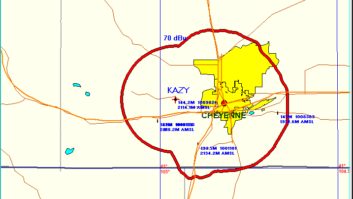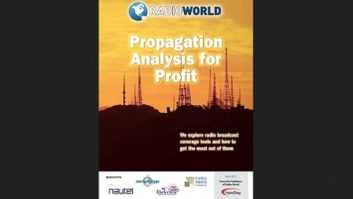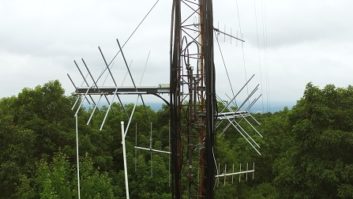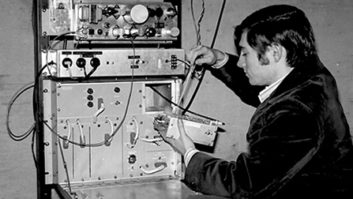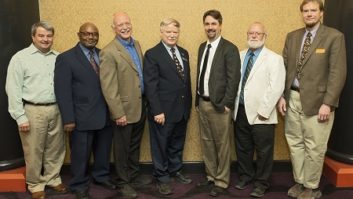Doug Vernier is the founder, president and senior engineer of V-Soft, the signal propagation software developer. His is a rarified but extremely important world.
TechBytes: How did you and V-Soft get started?

Doug Vernier: I used to do frequency searches back in the early 1970s using a legal pad and the broadcasting yearbook for station data. It was about that time that Tandy/Radio Shack came out with the Model I desktop computer.
Finally, a computer that most people could afford, even though the onboard memory, with the new expansion module, had only 64 KB. So, the first program I wrote for the computer using Radio Shack’s BASIC language was a search program for open frequencies. Back then there were a lot of open frequencies … not like today. The only way to fit a program into that 64 K was to write all the code without any spaces and to abbreviate everything.
It was pretty much unreadable. Once completed, you hoped the code worked, because finding an error was really time-consuming.
For several weeks, I used the kitchen table for my desk until my wife took umbrage, telling me to “get lost.” I moved it to a work bench in the furnace room and I can remember the Model I crashing sometimes when the furnace came on. However, sooner or later I had a working program to do FM frequency searches and somehow the word got out to a few consultants, and they wanted to have the program. By then, Tandy had come out with the Model III with those huge 10-inch disks, so the first programs I sent out were on the Model III disks.
That’s how we started, later I added people, a real office and we were in business.
TechBytes: How’s business and who is your customer?
Vernier: Business is fine, particularly on the support side. Our software clients include the FCC AM Branch engineers who use our AM-Pro every day and Industry Canada, the Canadian equivalent of our FCC. We have many consulting engineers, group engineers, including most of the larger group ownerships and individual station engineers using our software for propagation prediction, AM, FM and TV allocation and BAS/Part 101 Microwave analysis. There are also a few communications lawyers who use our software just to be up to date when their clients call.
TechBytes: How have things changed since you started in the business?
Vernier: Well, we used to have a larger universe of potential clients, however with broadcast industry consolidation the number of individual clients has been reduced significantly.
Then again, with the larger groups there are more potential clients who can afford our complete software packages, so in that regard things have worked out. We keep our costs lean and do as much as we can in-house rather than using third-parties. In the age of voice robots, one thing we try hard to do is answer our own phones. When our clients call there’s a real person who answers and is there to help.
TechBytes: You’re a familiar face at trade shows and V-Soft does a lot of road shows and seminars. Do your products have the buzz and get the attention they used to or are many of your customers, practicing engineers, spending less time with your products and more time with things like IT?
Vernier: To a degree some of this is true, we used to have a larger booth at the NAB conference, and opening day was bananas with people queuing up to talk to us. To sell our stuff to new users we have to spend a lot of time with people demonstrating how everything works and answer questions, so this side of our work is quite intensive.
As I noted, the universe for our products is rather small, so it takes the right kind of engineer who wants to save his/her company time and money; and, wisely, the engineers we deal with ask good questions to assure the product is the right fit. Another thing that’s happened over the years is that pretty much all of our competition has dropped out or moved over to development for other industries. To a degree, it is hard for others to compete with our broadcast products because we have become the standard for broadcast industry. We have had many years since 1972 of input from the engineers who regular use our software and this has helped us hone-in on what they really want. If you have to get the same numbers that the FCC gets on their computers you need our software, so there’s not much, if any, real competition.
The more useful our product is to the engineer the better the “vibe” will be. This is why we continue to offer training seminars throughout the country, in our Iowa office or through Internet Webinars. For example, we have recently scheduled three webinars in September on three of our mainline products, FMCommander, Probe 4 and Microwave Pro 2.
TechBytes: Do stations/broadcast groups devote enough resources to things like signal test, measurement, propagation?
Vernier: Any engineer who wants their job will quickly carry out tests and measurements when the CEO walks in and says, “Why does our signal sound so crappy?” Measurements are being taken every day by good engineers to keep on top of things and to be sure everything is square with the FCC. Often you will see some of the larger groups working together on things like AM carrier suppression modulation, FM modulation techniques to eliminate multipath, and on the TV side, ATSC 3.0. So, rather than individual group efforts, the trend today for testing and measuring is in joining forces to improve signal propagation for the whole system. NRSC has been doing this for a long time and has made great strides for broadcast improvements.





